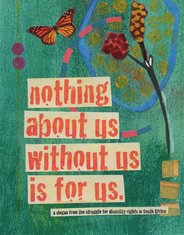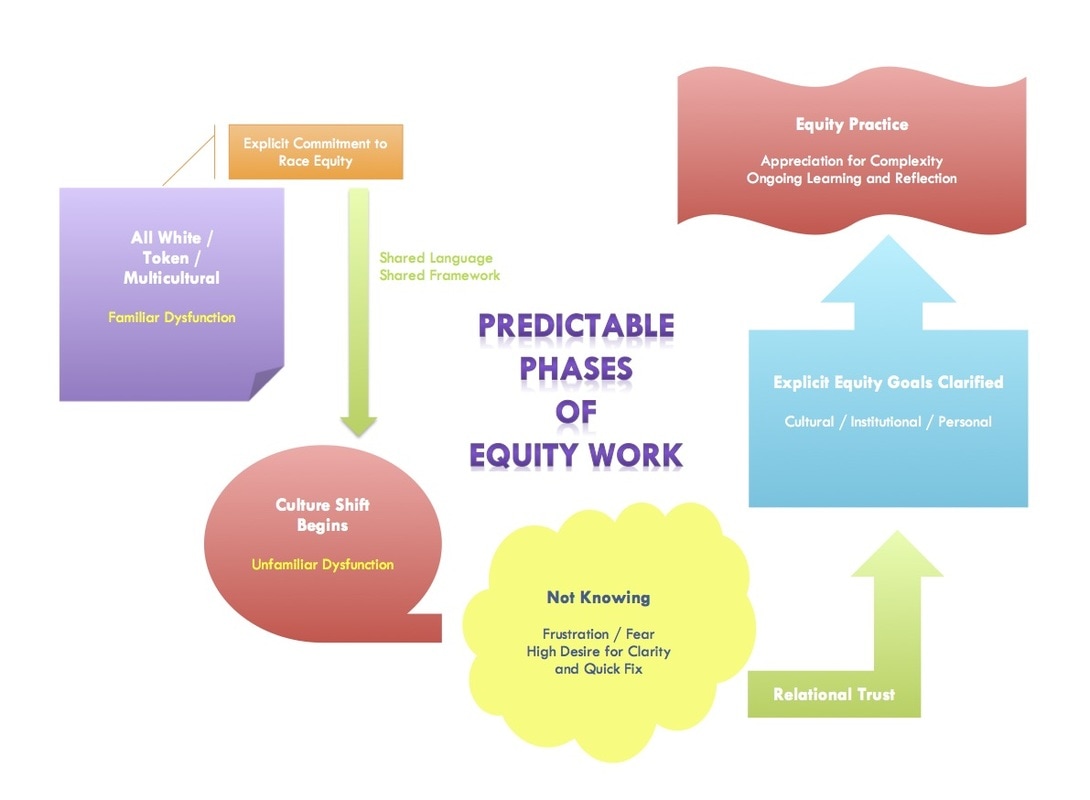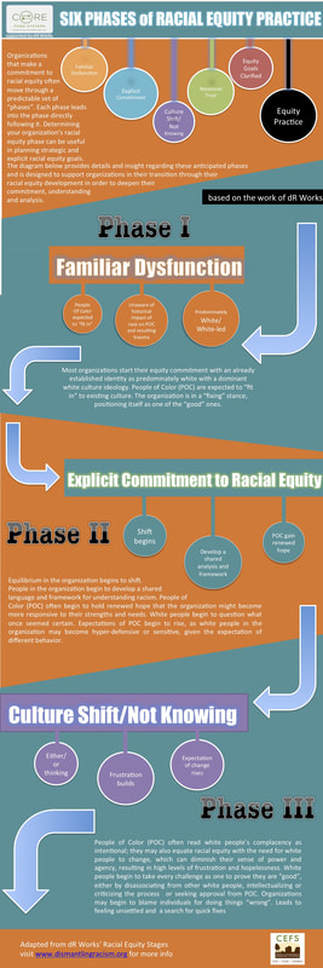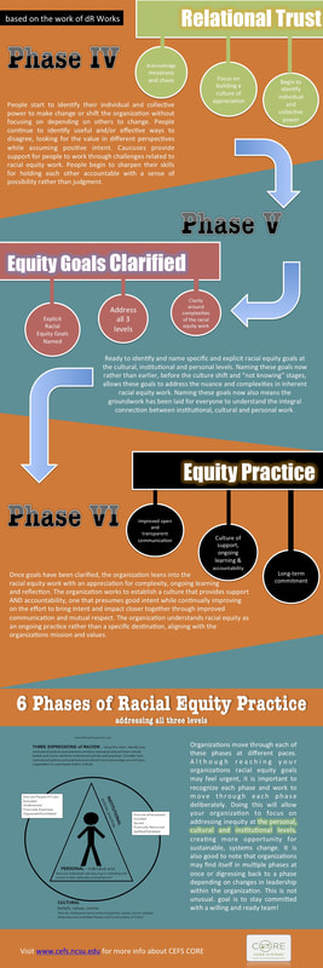|
Organizations who make a commitment to race equity move through somewhat predictable stages, illustrated in the accompanying diagram. Familiar Dysfunction Many organizations start their equity commitment with an already established identity as white-led, predominantly white, or operating out of a dominant white culture ideology. The organization might be operating as an all white organization, as an organization with token participation by POC who are expected to “fit in” to existing white dominant culture, or as a multicultural organization that appreciates diversity without challenging racist and/or dominant white culture practices and ideology. In this stage, all people in the organization are operating in a state of what could be called “familiar dysfunction.” Essentially, everyone in the organization has adjusted to the way the organization centers white dominant culture norms at the expense of everyone and particularly POC in the organization and/or Communities of Color served by the organization. Often (if not always), POC in the organization and those being served are experiencing levels of trauma as a result of racism and internalized racism in the larger society and in the organization. Many white people in the organization are unaware of the level of trauma POC are experiencing or if aware, are taking responsibility individually, often by separating themselves from other white people in order to position themselves as the “good” white person. People across the organization tend towards a “fixing” stance, meaning that individuals and the organization as a whole is on a mission to “fix” others, often in the name of empowerment. While individuals in the organization may be very satisfied to very dissatisfied, people have generally accepted the status quo as inevitable and have learned to function within it. Explicit Commitment to Race Equity As the organization begins to state an explicit commitment to race equity, equilibrium begins to shift. As people in the organization begin to develop a shared language and framework for understanding racism as race prejudice + social and institutional power, the familiar dysfunction begins to unravel. People of Color often begin to hold renewed hope that the organization might become more responsive to their strengths, needs, and wisdom; white people often begin to question what once seemed certain, particularly when it comes to their assumed power in the organization. As POC’s expectations for the organization begin to rise, particularly as a framework for racism begins to be clarified, they may assume that white people know what to do and are nonetheless choosing to perpetuate racist attitudes and behaviors. As white people sense that the framework requires some change in attitudes and behaviors, they may become either hypersensitive or hyperdefensive, particularly as they sense the expectation that they should behave and believe differently while not knowing exactly what to do. Culture Shift This is the beginning of a culture shift in the organization. POC often read white people’s ignorance as intentional; they may also equate race equity with the need for white people to change, which can diminish their sense of power and agency. As a result, they may feel high levels of frustration and/or hopelessness. White people often become so unsettled by no longer having power to define the organizational “norms” that they begin to take every challenge by others, whether from a white person or a POC, as very personal and begin to try to prove they are one of the “good” white people, either by disassociating from other white people, intellectualizing the process, criticizing the process, or seeking approval from individual POC. People in the organization begin to “flip the script;” the organization engages in either/or thinking that positions POC as inherently good and white people as inherently bad. At this stage, the organization tends to blame individuals for doing things “wrong” and there is little ability to hold complexity or appreciate oneself or others. This flipping of the script into either/or thinking can increase the sense of traumatization on the parts of both POC and white people, as expectations for needed and desired change are not met. Not Knowing This leads to the stage of “not knowing,” a place where many experience frustration and/or fear. Many if not most people want the process to offer clarity and quick fixes; when the process does not, both POC and white people give into the tendency to identify people and actions as “right” or “wrong.” Some people in the organization move into positions of high righteousness, believing that race equity is based in “one right way” of doing things; energy goes into identifying who or what is “right” and who or what is “wrong.” People can feel very unsettled because this righteous judgment can either lead to significant self-doubt and/or a desire for the organization to address personal ego needs. At the same time, in the middle of this “not knowing,” relationships may begin to subtly shift as some individuals within the organization work to negotiate conflict with heightened personal awareness and increased accountability to the mission. In addition, the organization as a whole begins to recognize ways in which racism is tending to reproduce itself and attempts are being made to address those. Relational Trust At this point, the organization acknowledges that culture shift is messy and chaotic and focuses on efforts to build relational trust and a culture of appreciation to help move people and the organization through the chaos. People start to identify their individual and collective power to make change or shift the organization without focusing or depending on others to change. People continue to identify useful and/or effective ways to disagree, looking for the value in different perspectives while assuming positive intent. Caucuses provide support for people to work through challenges related to equity work. People begin to sharpen their skills for holding each other accountable with a sense of possibility rather than judgment. Both POC and white people are working to bring intention and impact closer together out of a mutual respect for the hard personal work involved in a race equity commitment. OR ... In cases where the organization is unable to hold the chaos of not knowing, it reverts to familiar dysfunction, often solidifying old patterns of power and privilege. The rationales for reverting to dysfunctional white supremacy patterns include a need for clarity (which is essentially an admission that those with power in the organization are too disturbed by changing power dynamics), urgency related to the organization’s mission (“we don’t have time for this,” “we can’t afford to be distracted,”), the need to produce measurable results for funders, among others. Some people may leave or threaten to leave the organization. While the reasons are often different, both POC and white people can become advocates for reverting to familiar dysfunction. Equity Goals Clarified At this stage, the organization is ready to identify and name specific and explicit race equity goals at the cultural, institutional and personal levels. Naming these goals now rather than earlier, before the culture shift and “not knowing” stages, allows these goals to address the nuance and complexities inherent in race equity work. Naming these goals now also means the groundwork has been laid for everyone to understand the integral interconnection between institutional, cultural, and personal work. Equity Practice Once goals have been clarified, the organization leans into the equity work with an appreciation for complexity, ongoing learning and reflection. The organization works to establish a culture that provides support and accountability, one that presumes good intent while continually improving on the effort to bring intent and impact closer together through improved communication and mutual respect. The organization understands race equity as an ongoing practice rather than a specific destination. People have learned how to offer appreciation, disagree, make mistakes, call into account, reflect and revise. People have also learned to identify their individual bottom lines and know when and how to stand their ground while remaining accountable to the organization’s vision and mission. |
There is no such thing as a single-issue struggle because we do not lead single-issue lives. |
race equity stages 2
This graphic illustration of the stages of racial equity are designed and offered by Shorlette Ammons, who works with the Center for Environmental Farming Systems, a collaboration of NC State University, NC A&T University, and NC Cooperative Extension. Big thanks to Shorlette for this beautiful graphic. For best viewing, download here.
how a
|
Movements for social change emerge when:
Our work within organizations must be approached as movement building work. Organizers, working to create organizational change with a movement mentality, can:
|
|
barriers and bridges principlesThese principles were developed by Grassroots Leadership's (Charlotte, NC) Barriers and Bridges program, a precursor and contributor to the Dismantling Racism process for which this workbook is designed. These principles speak to the assumptions and values that ground dismantling racism work.
|



